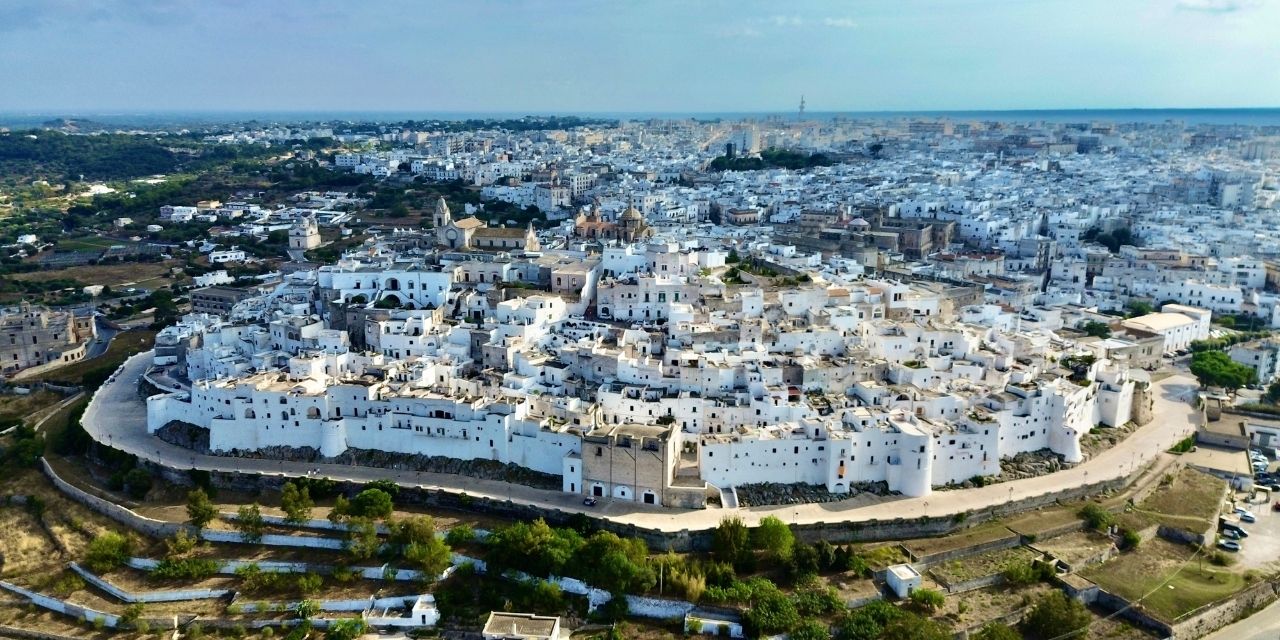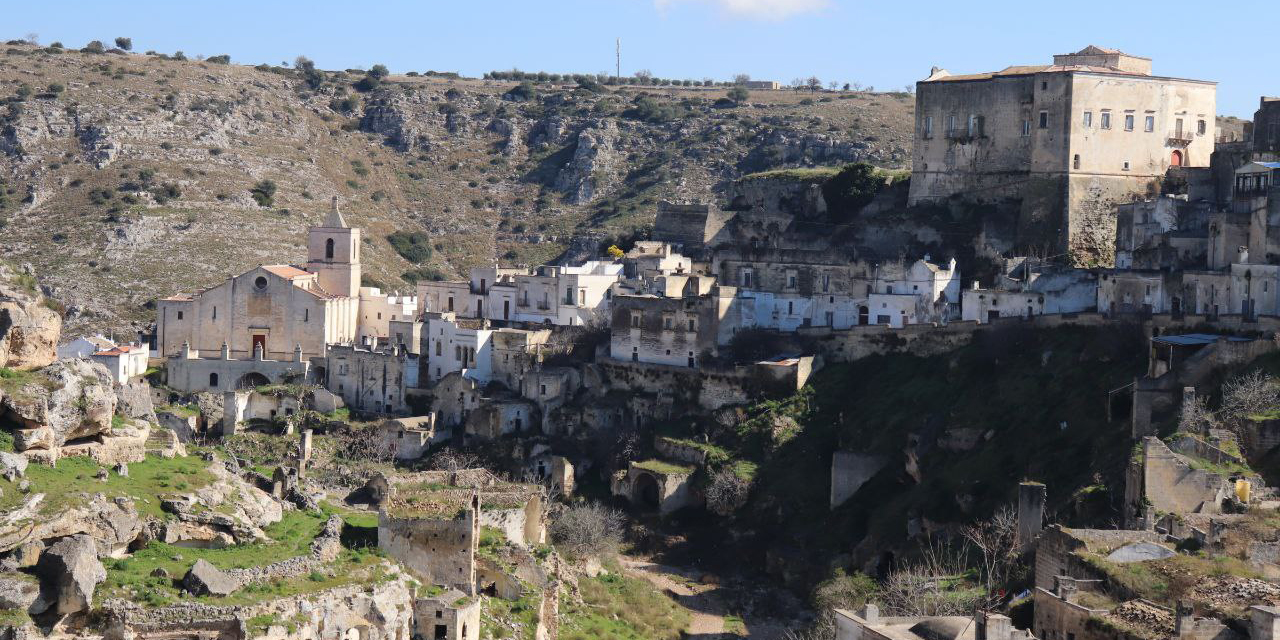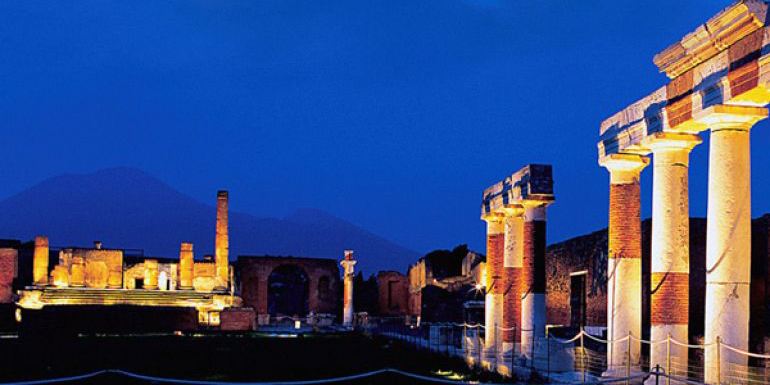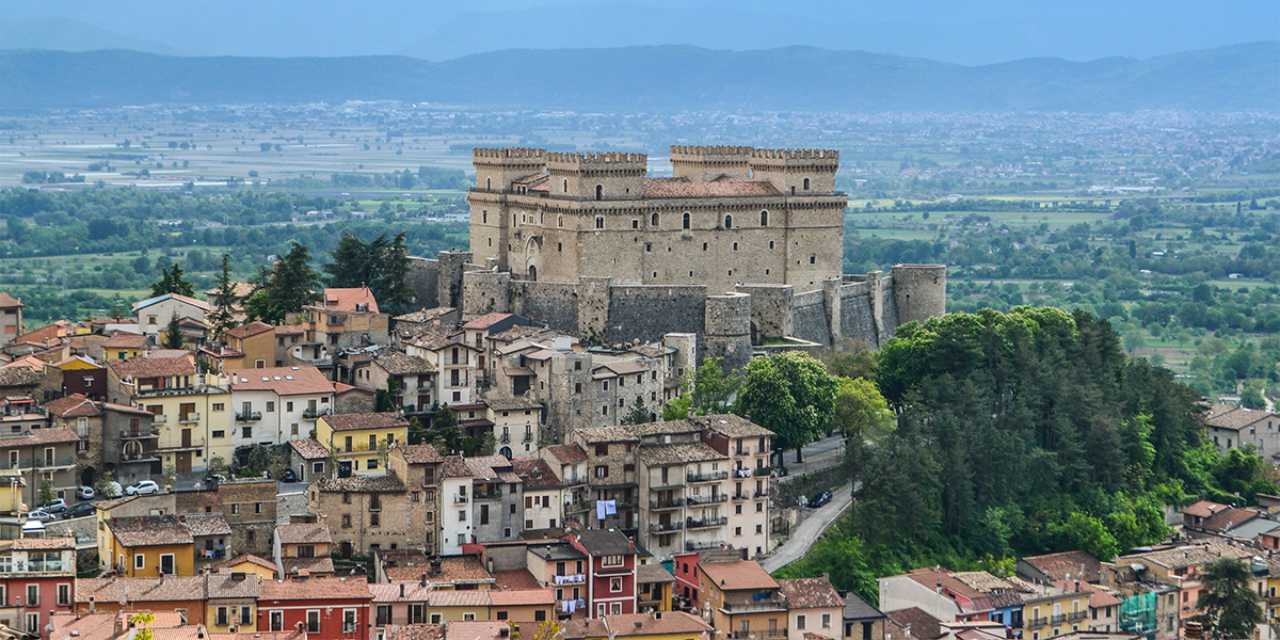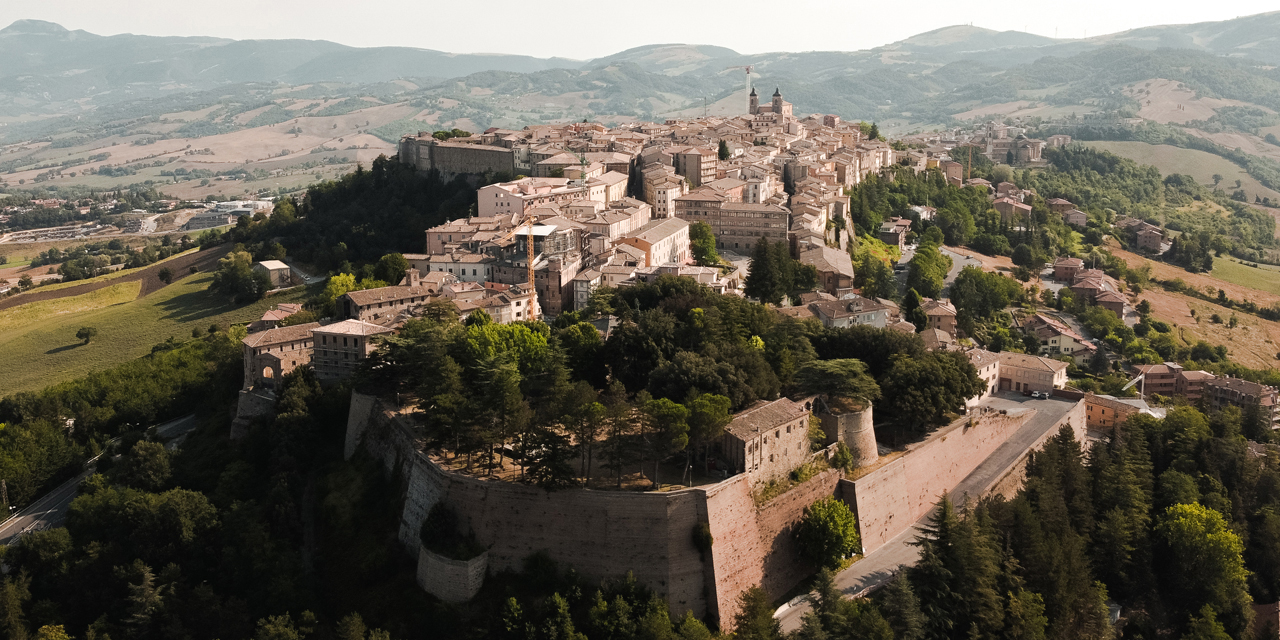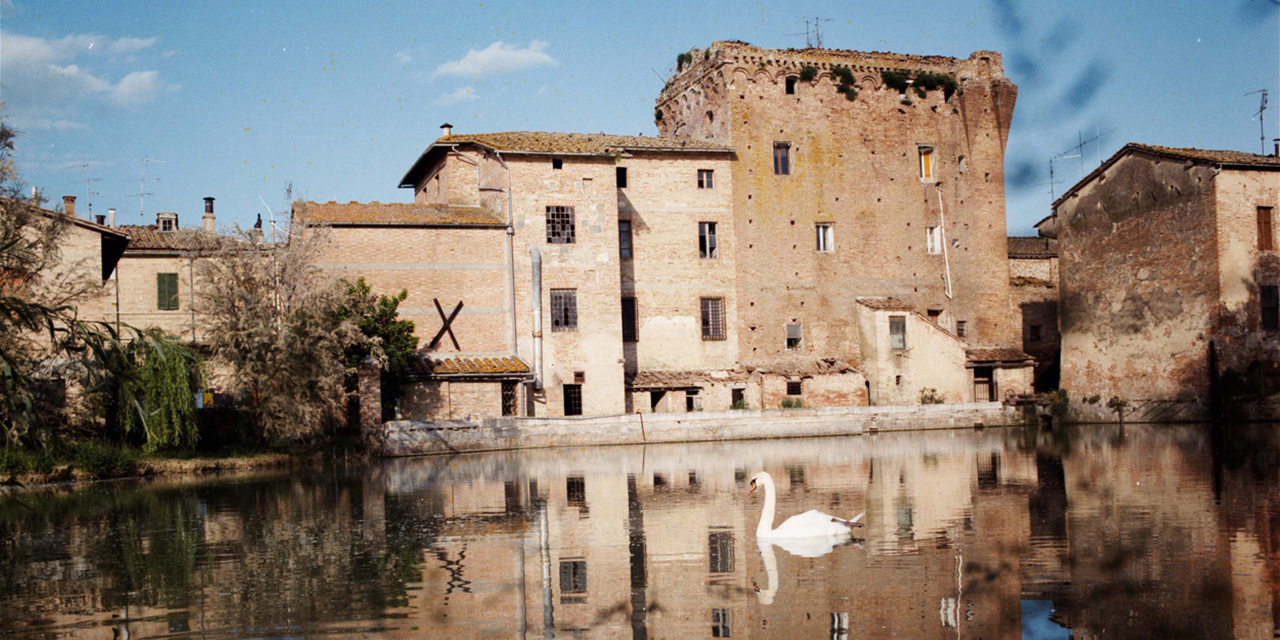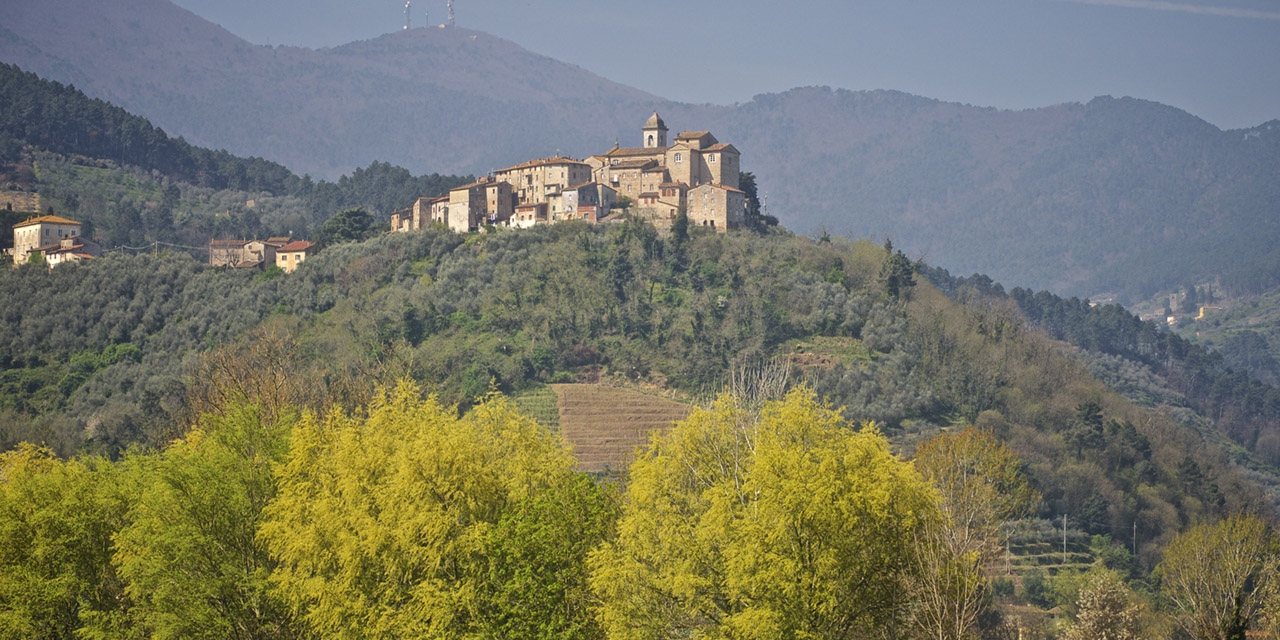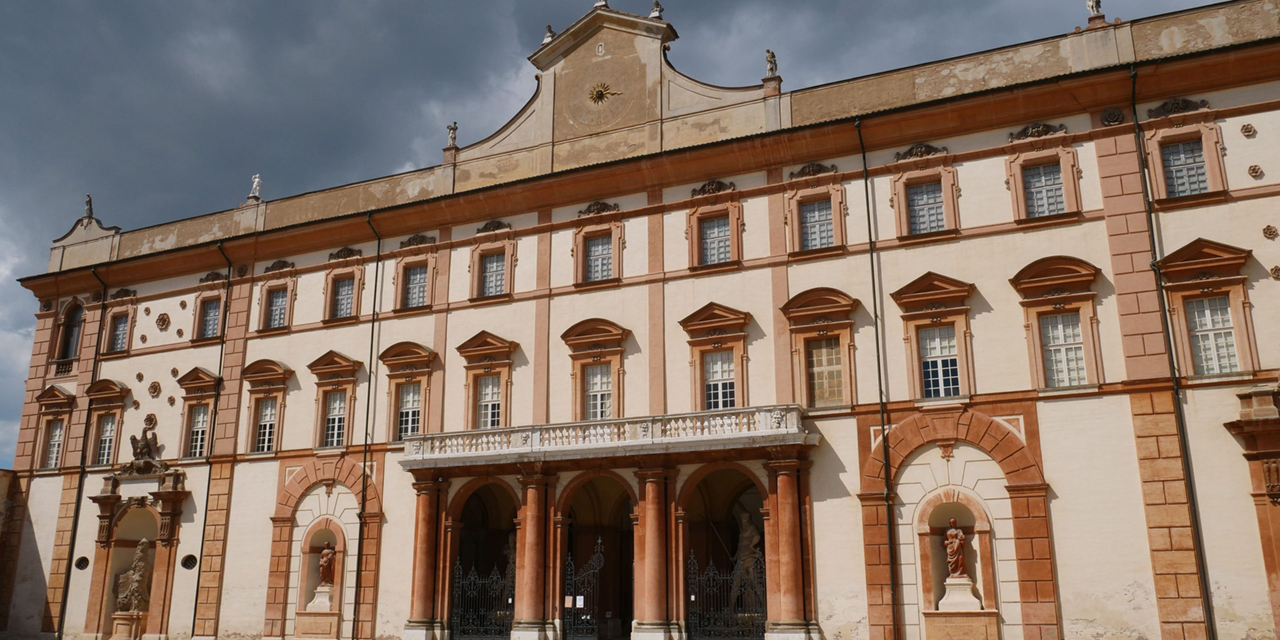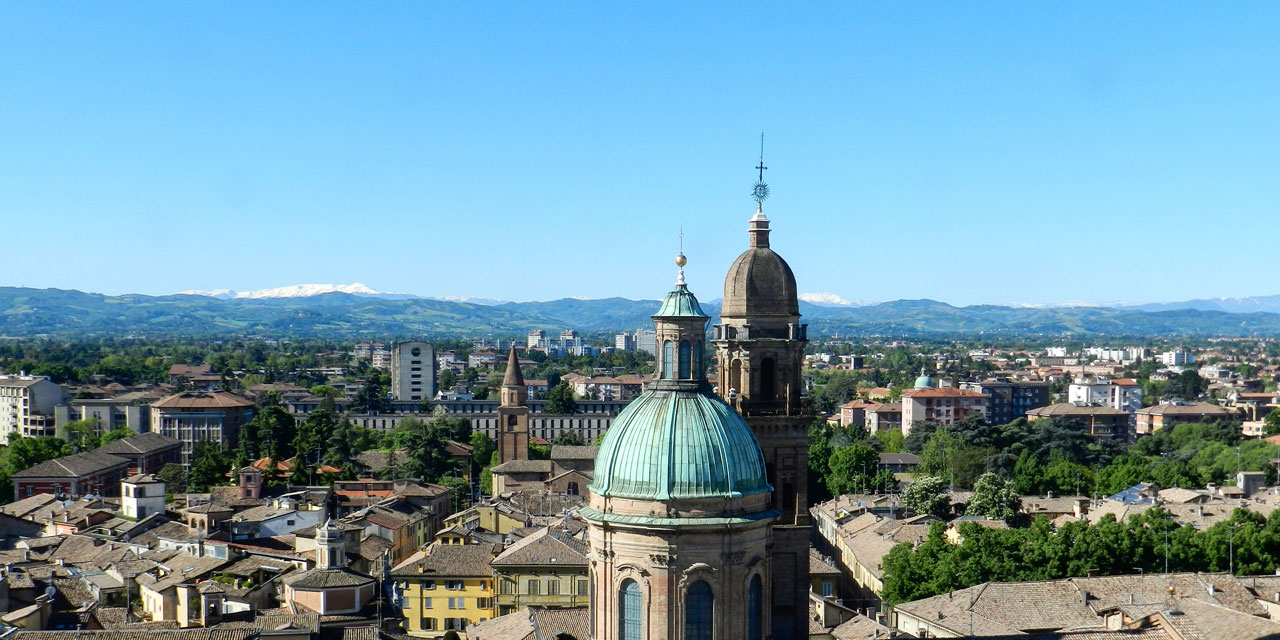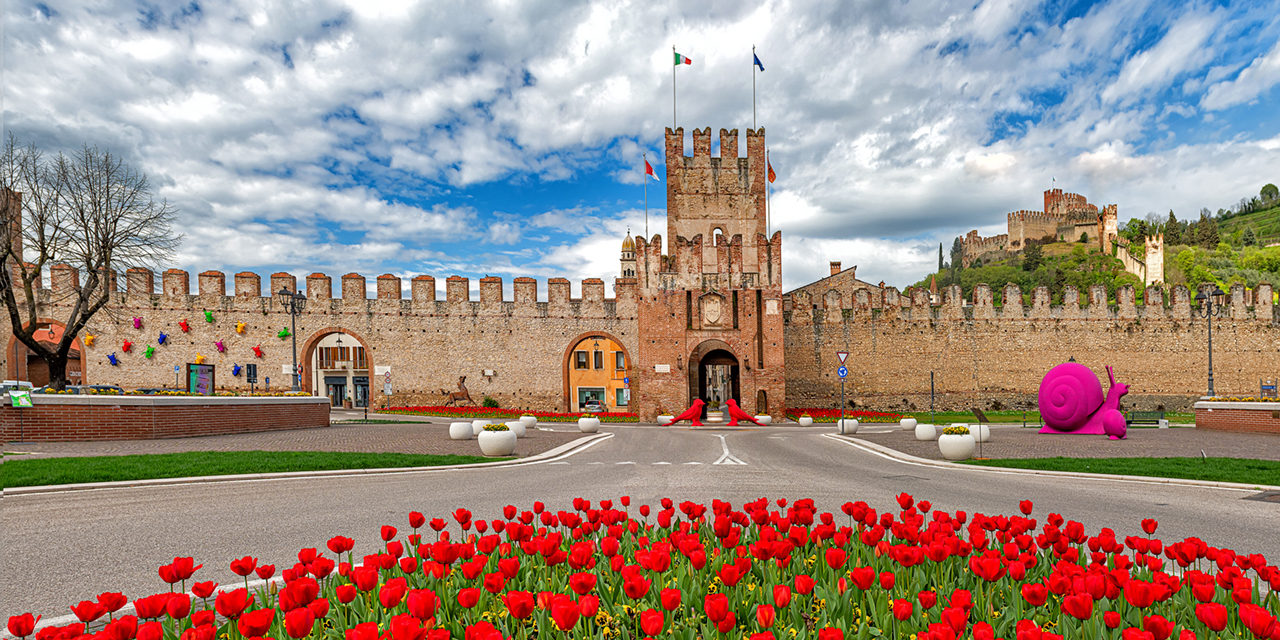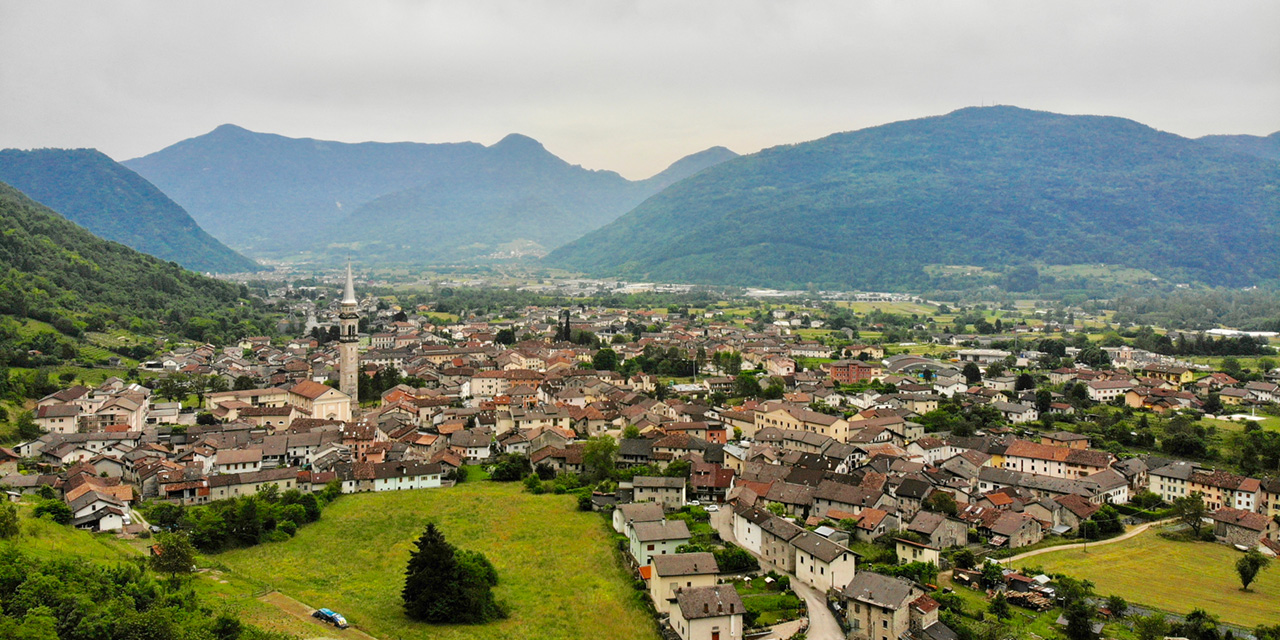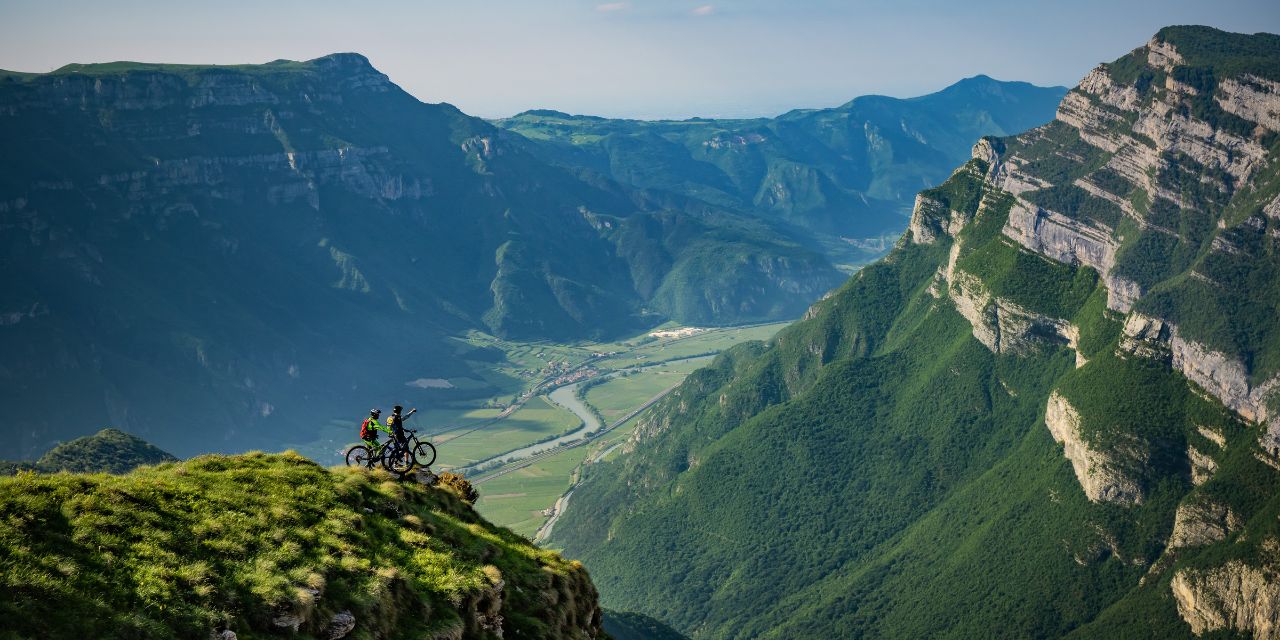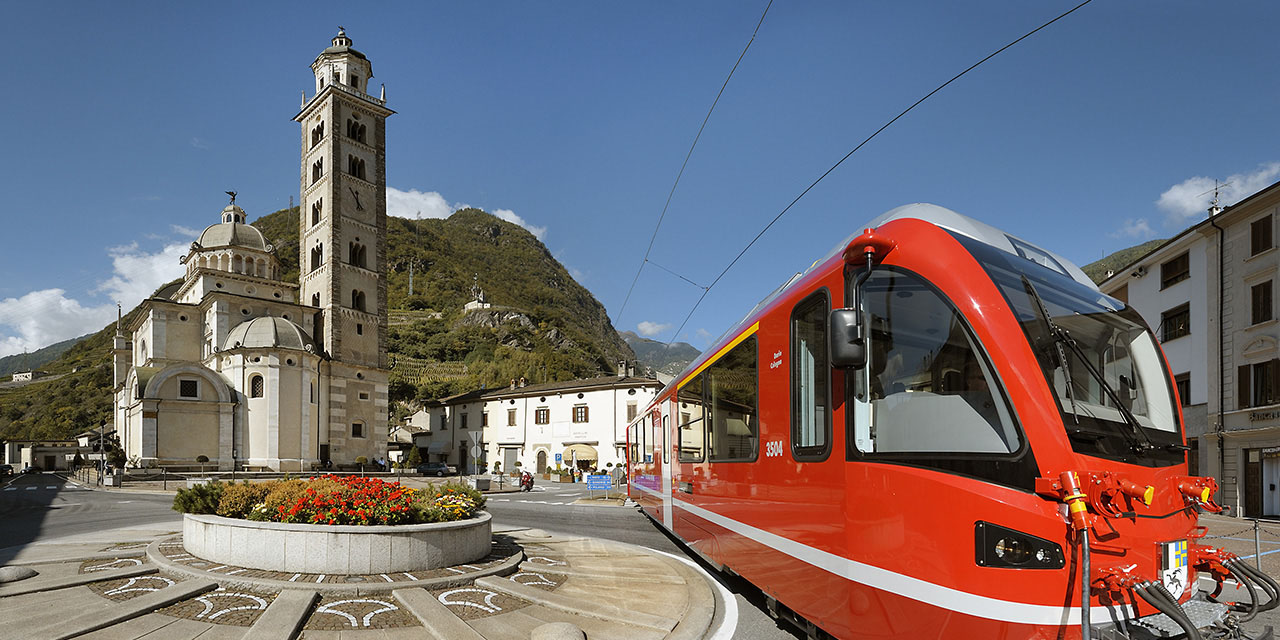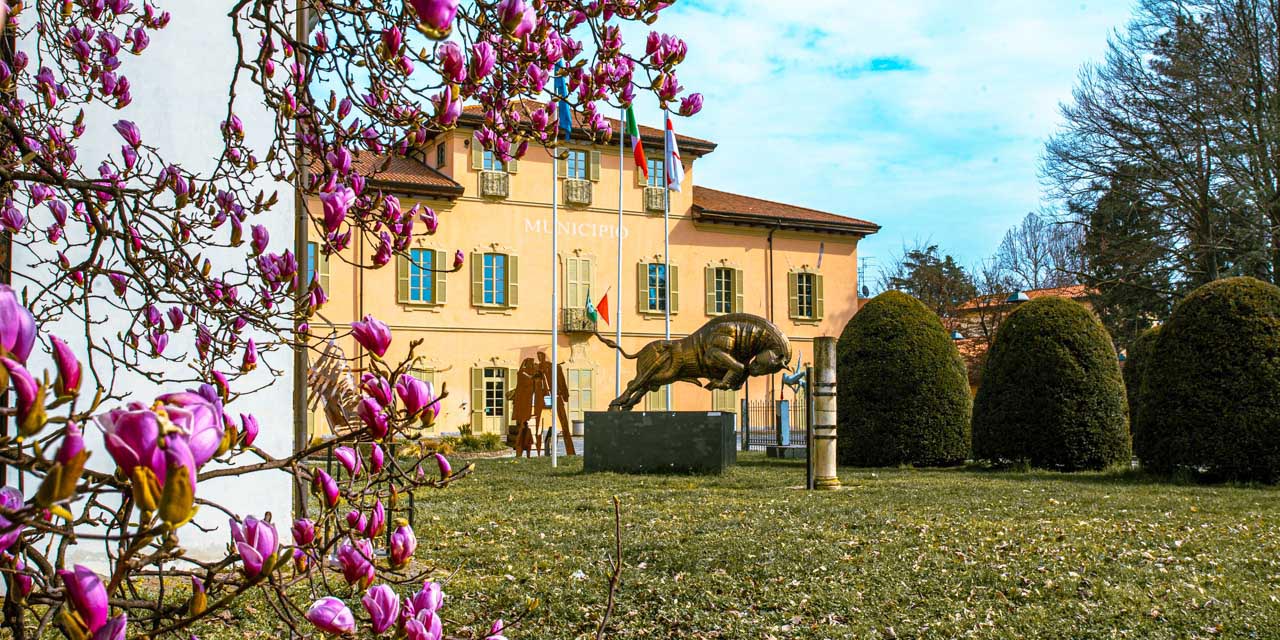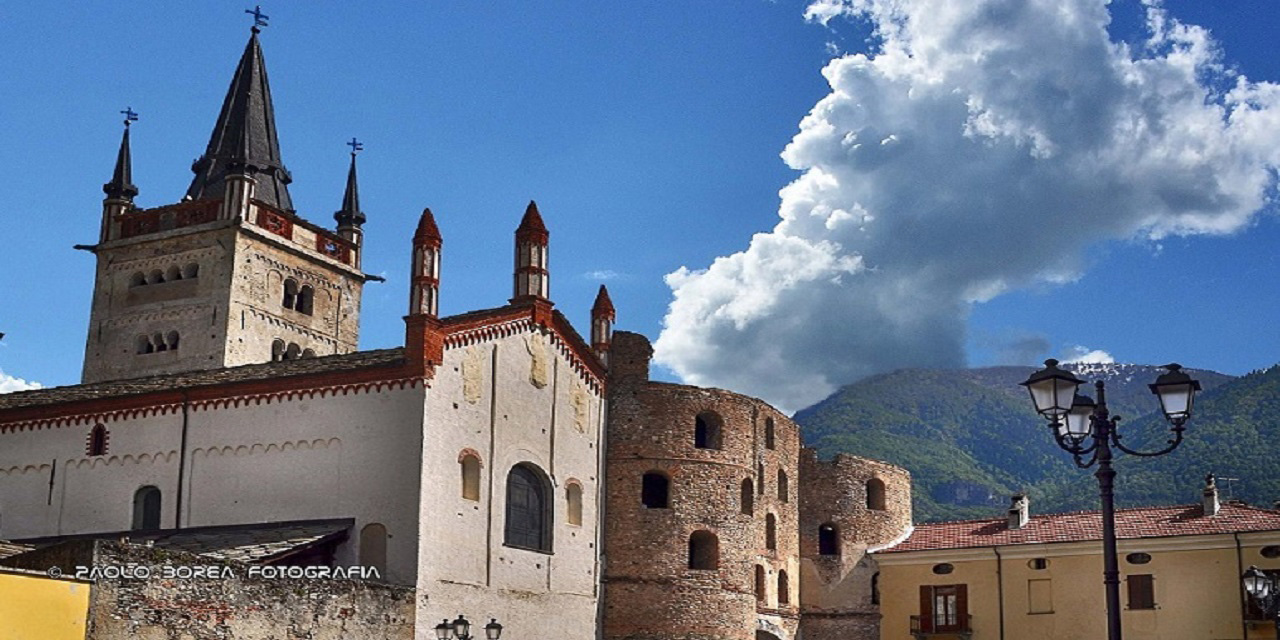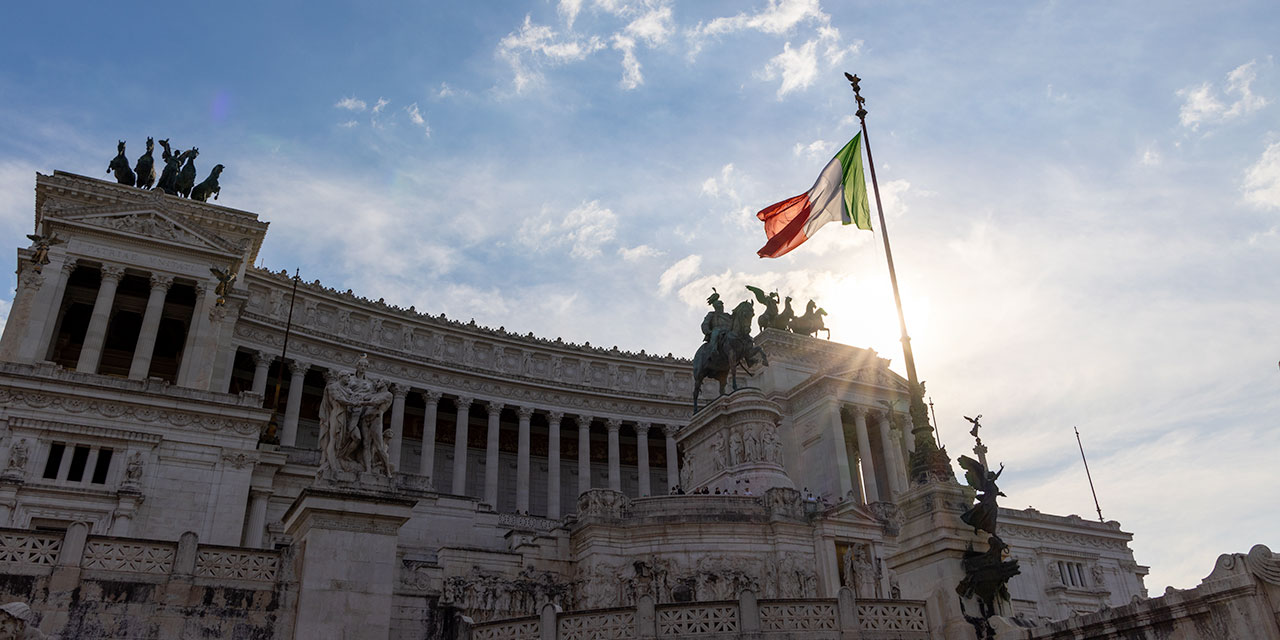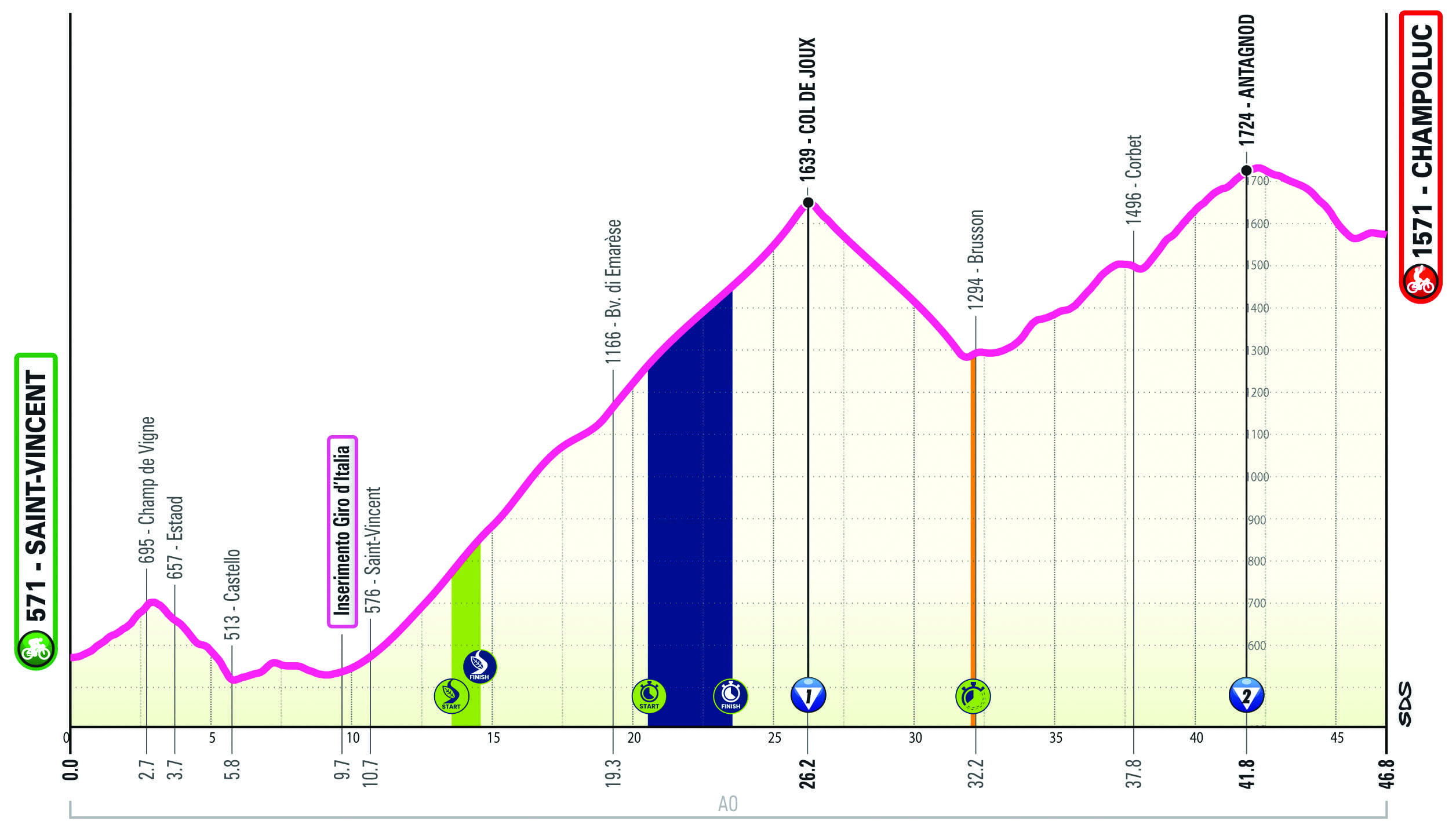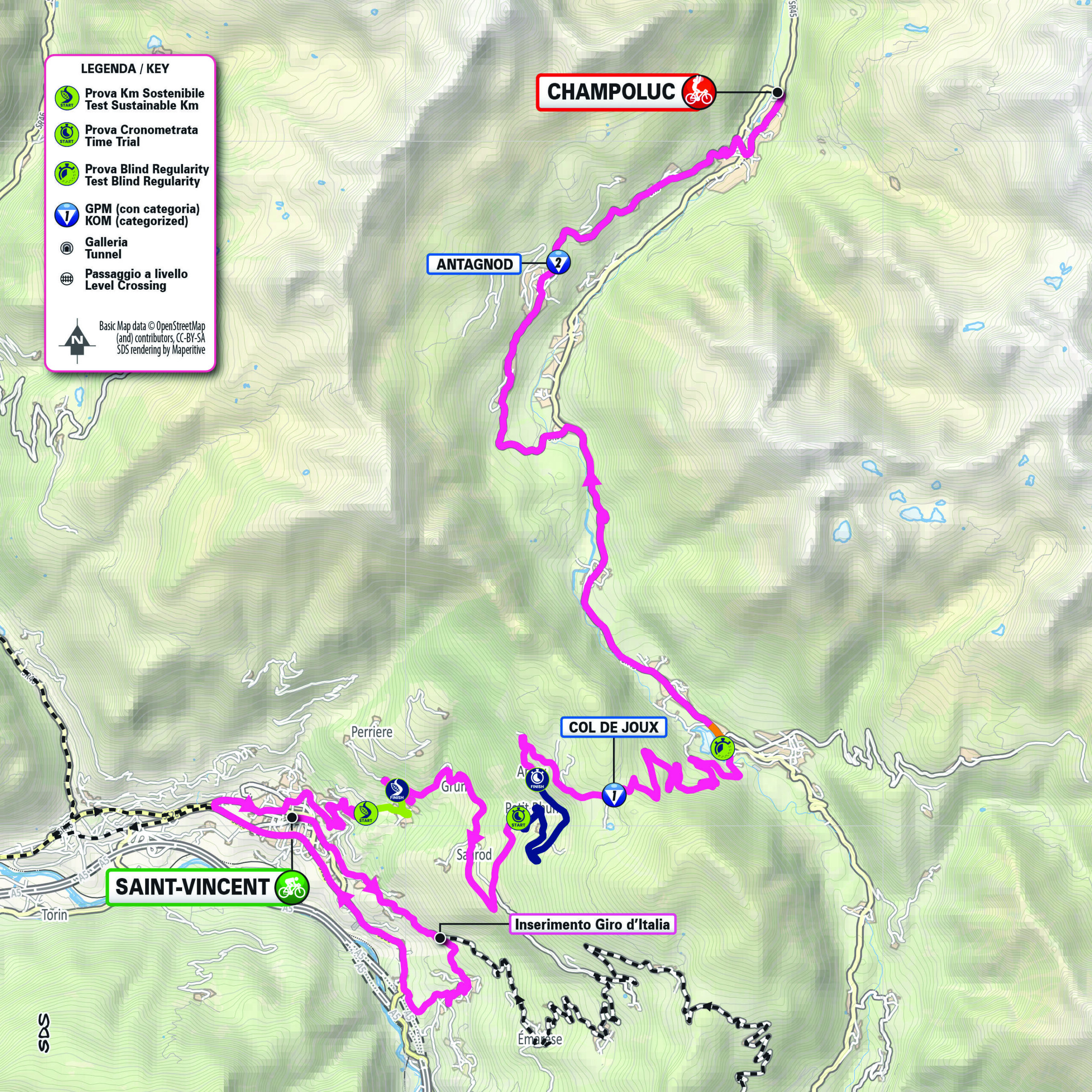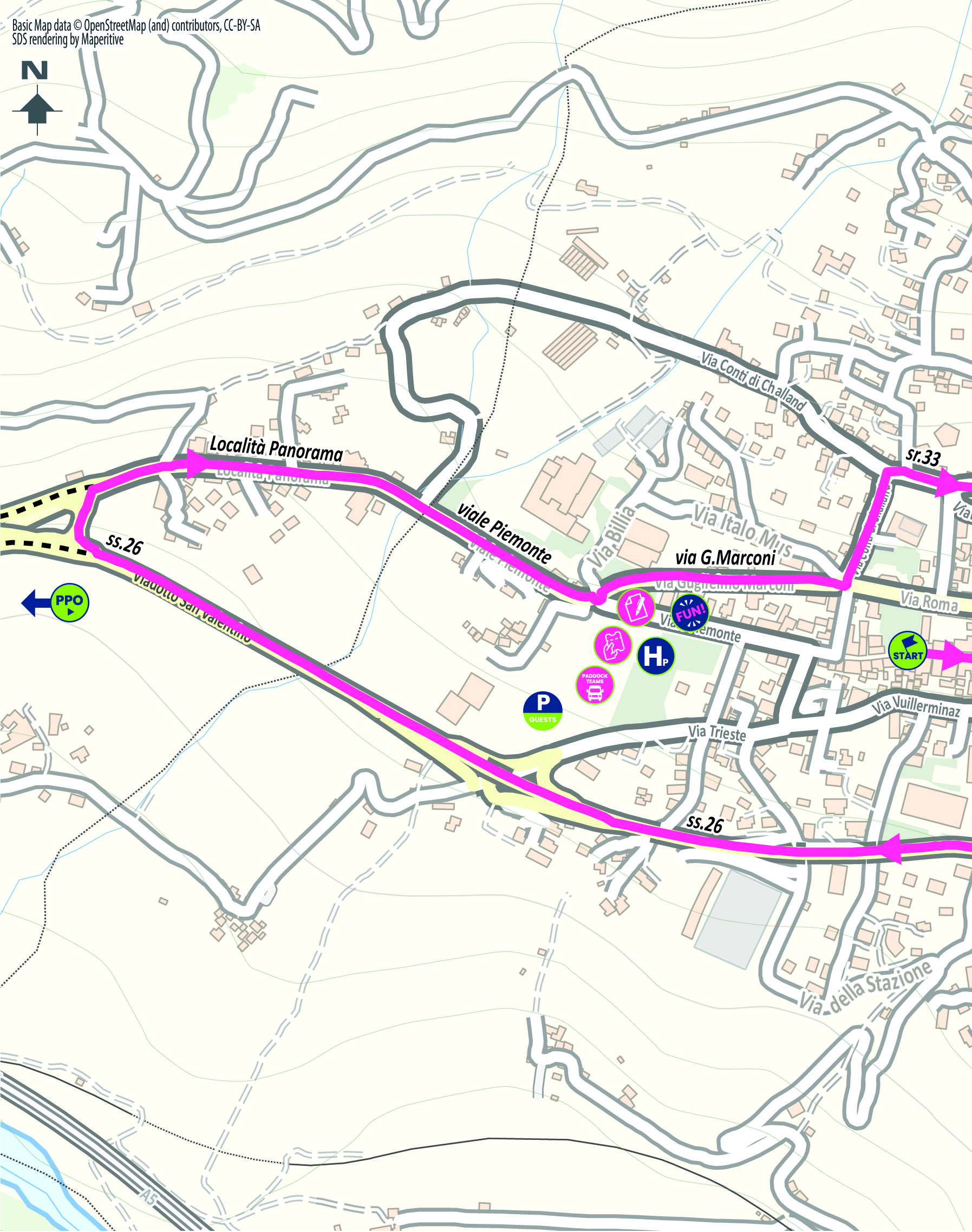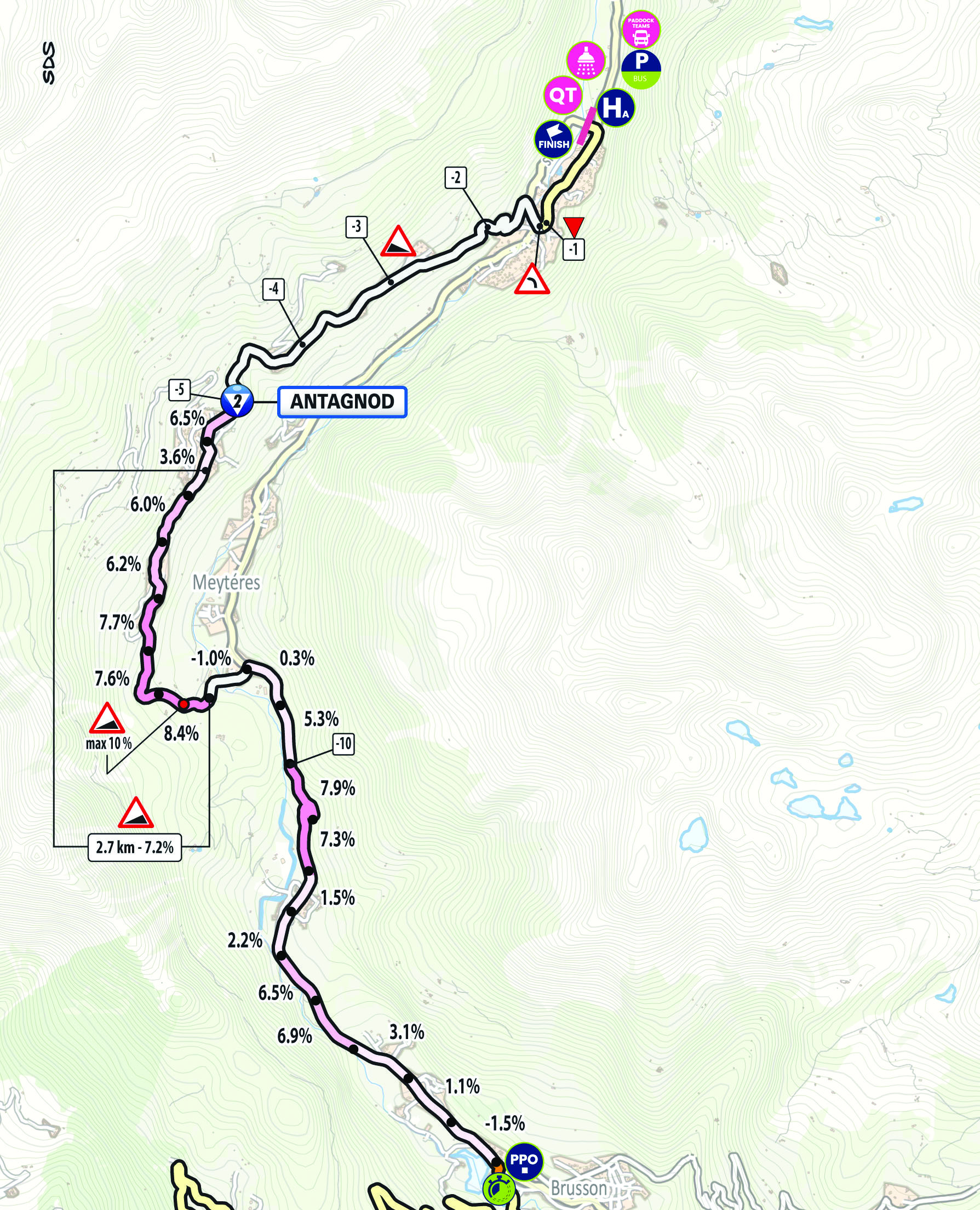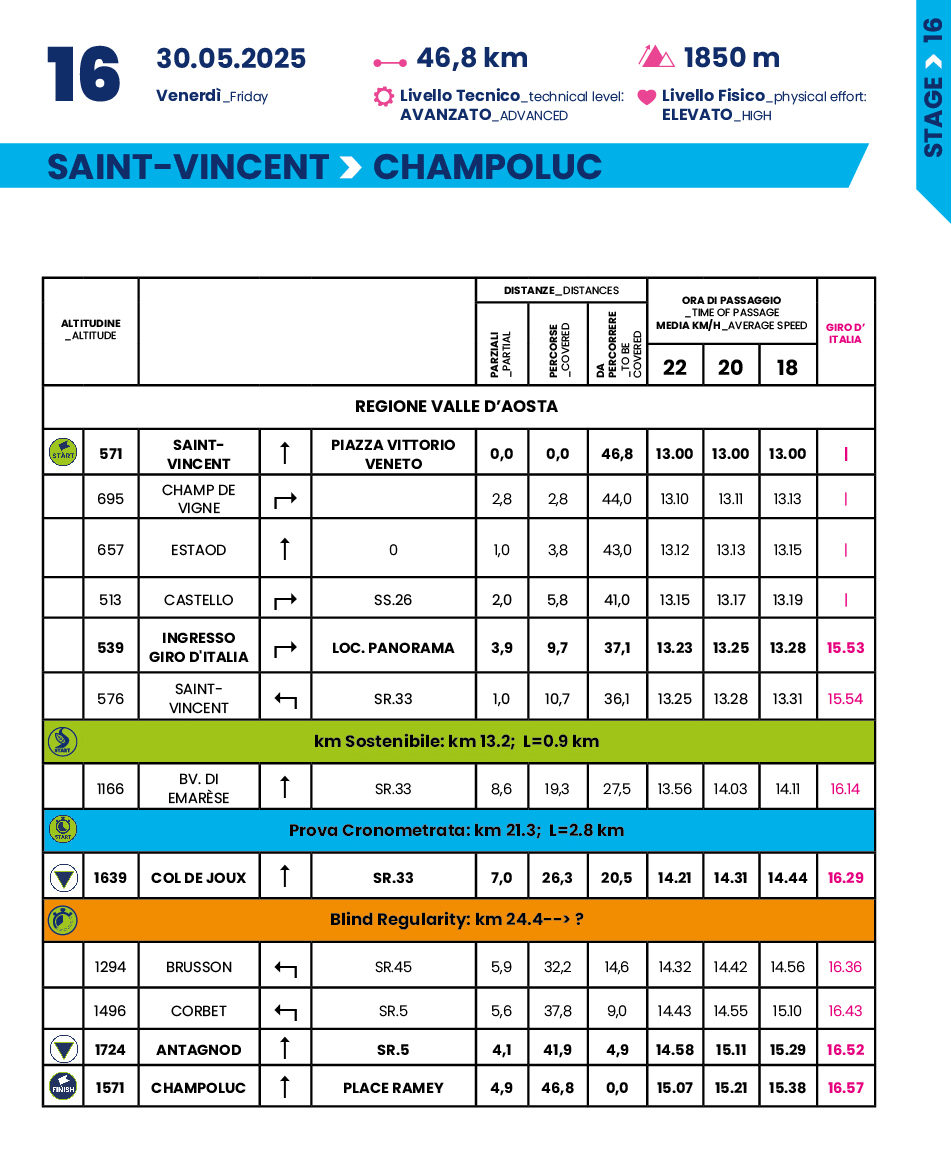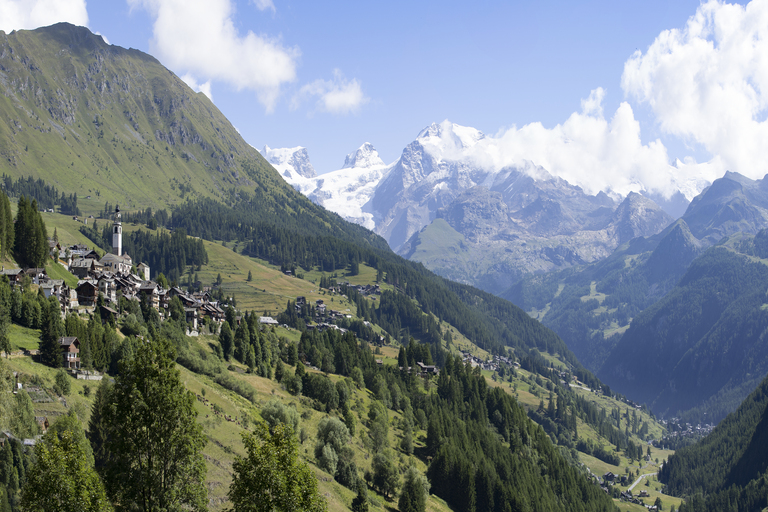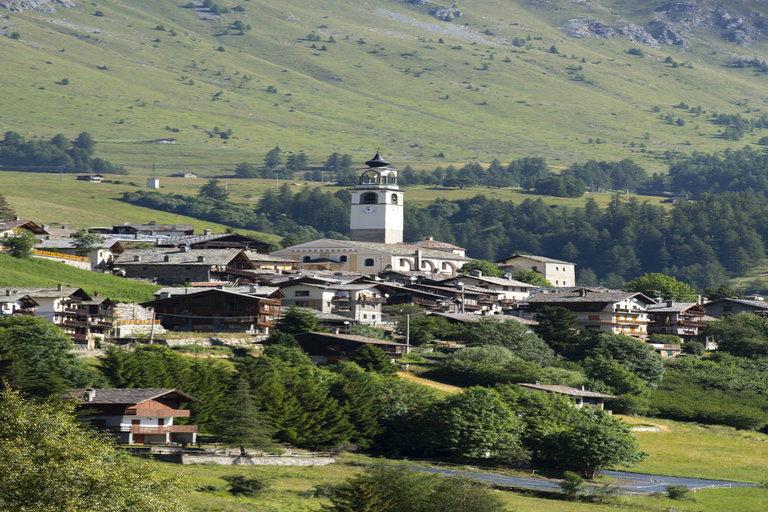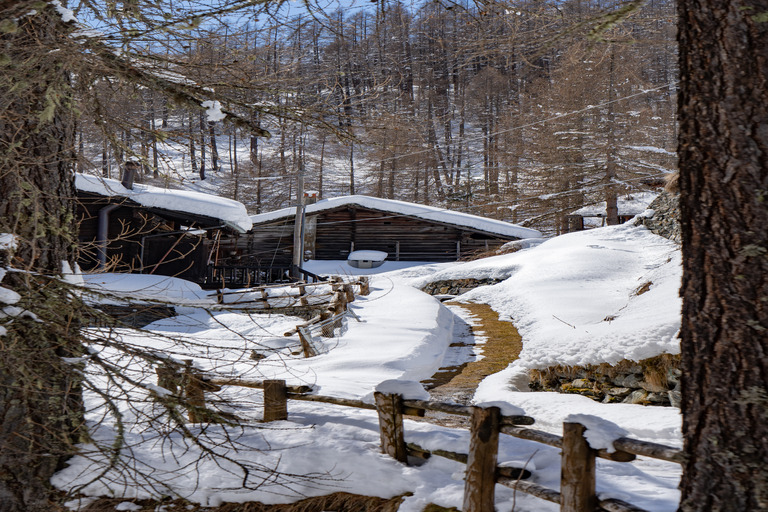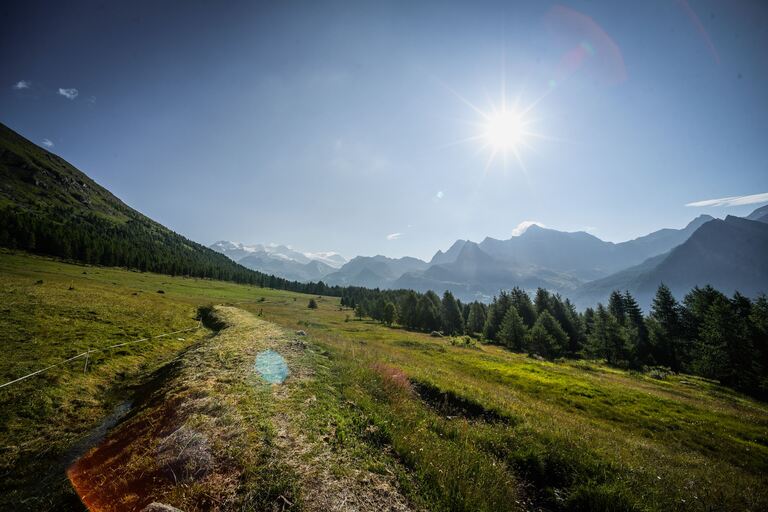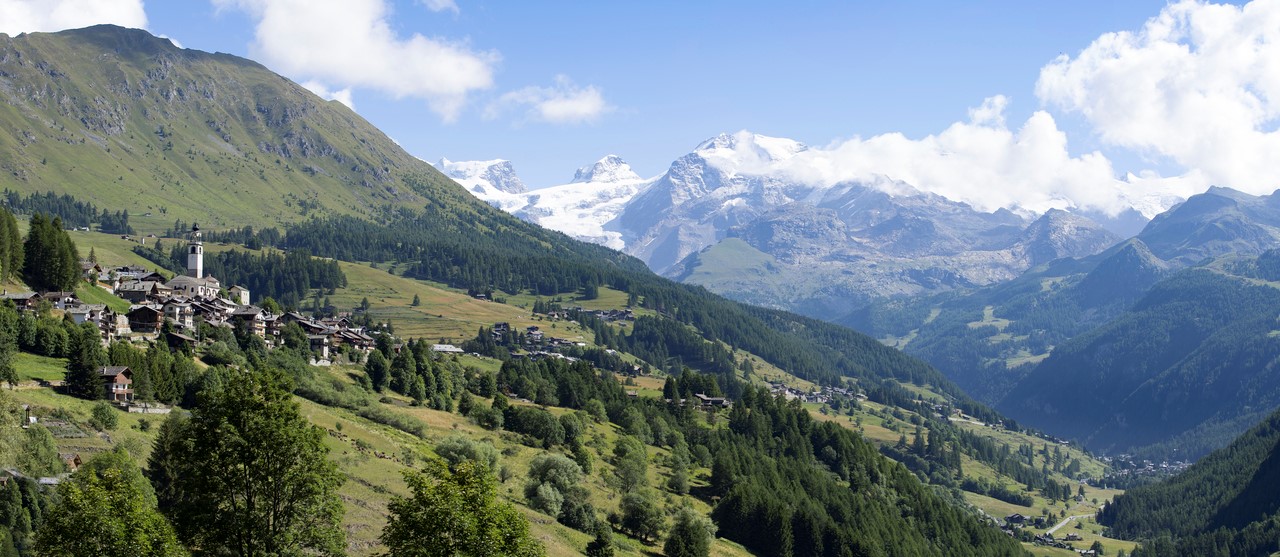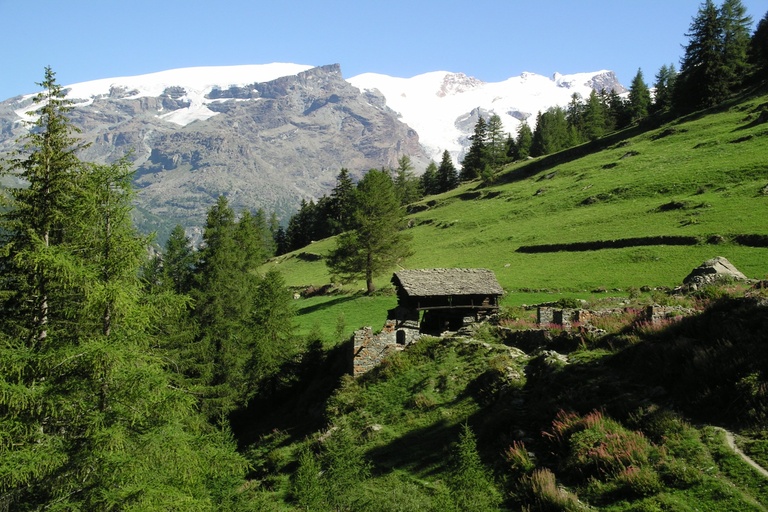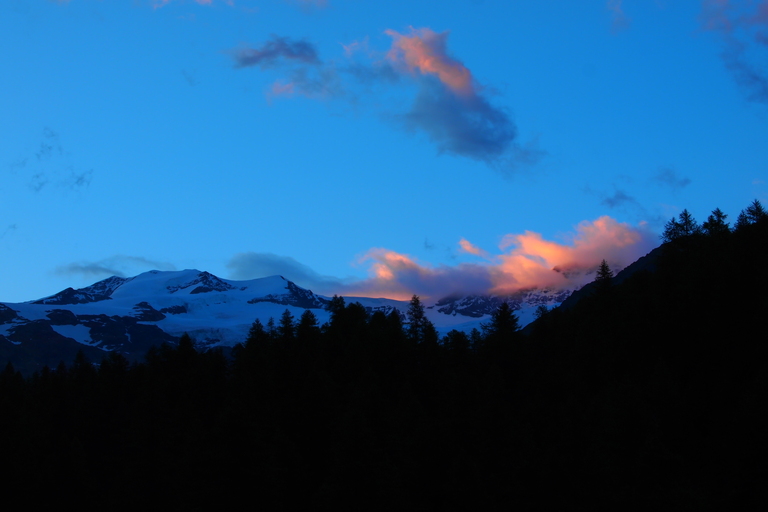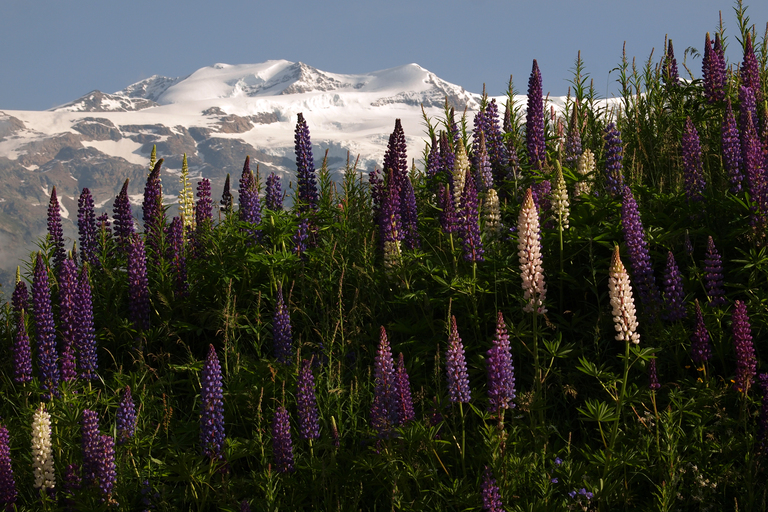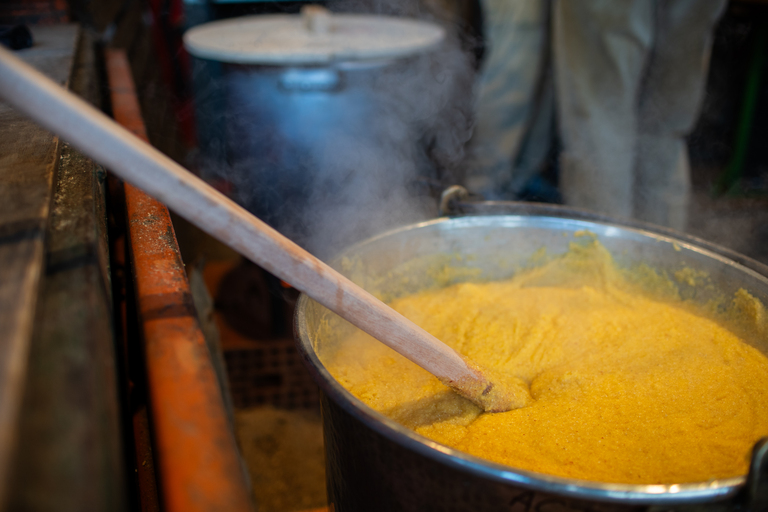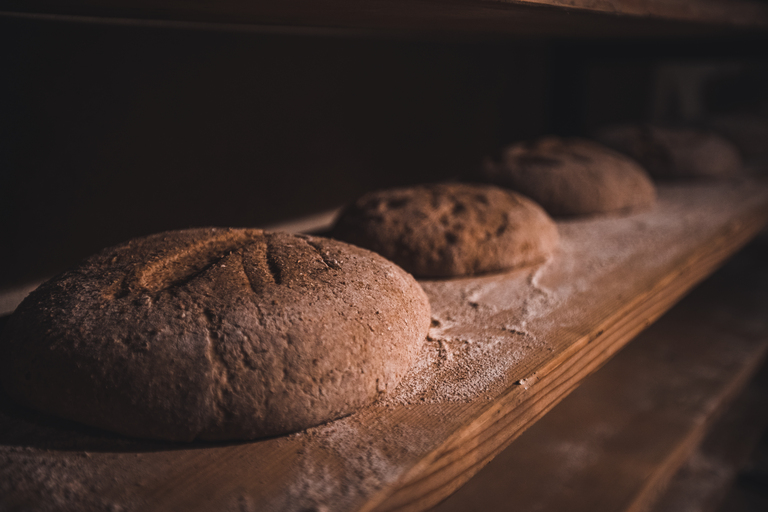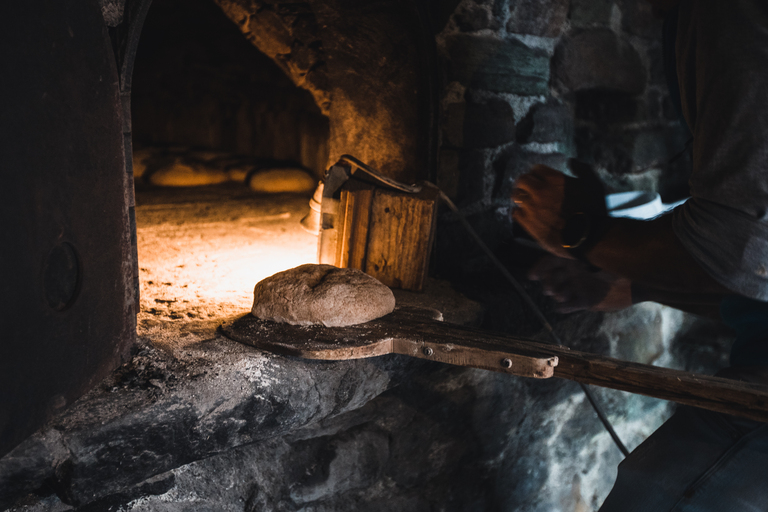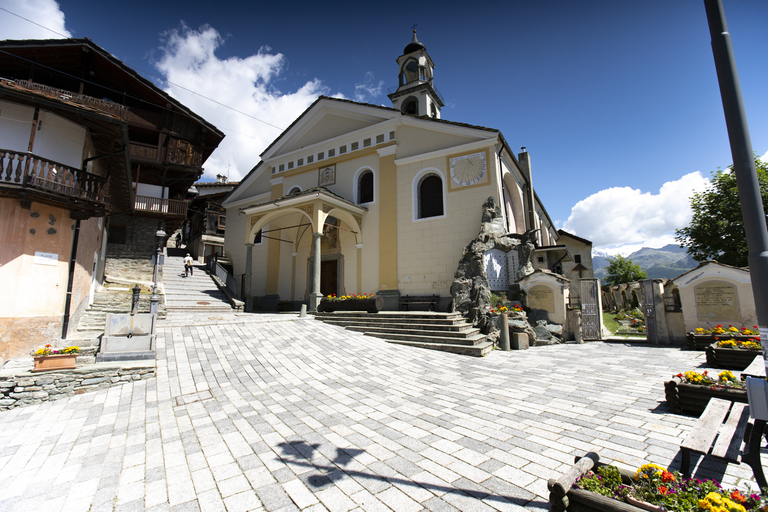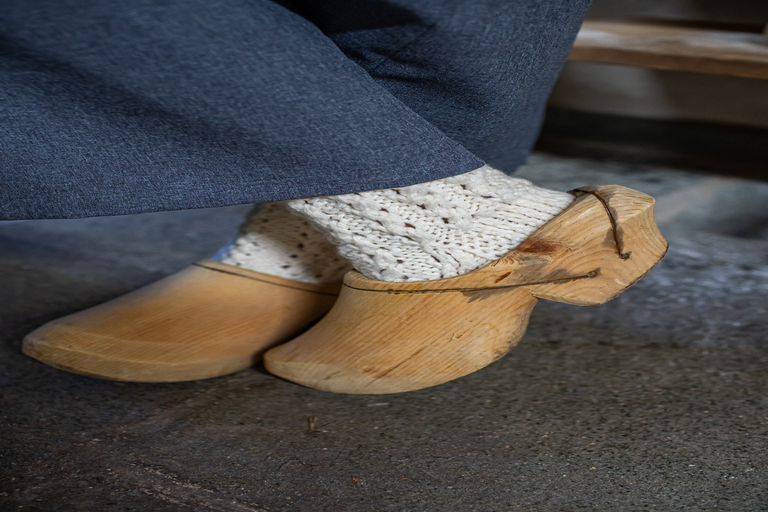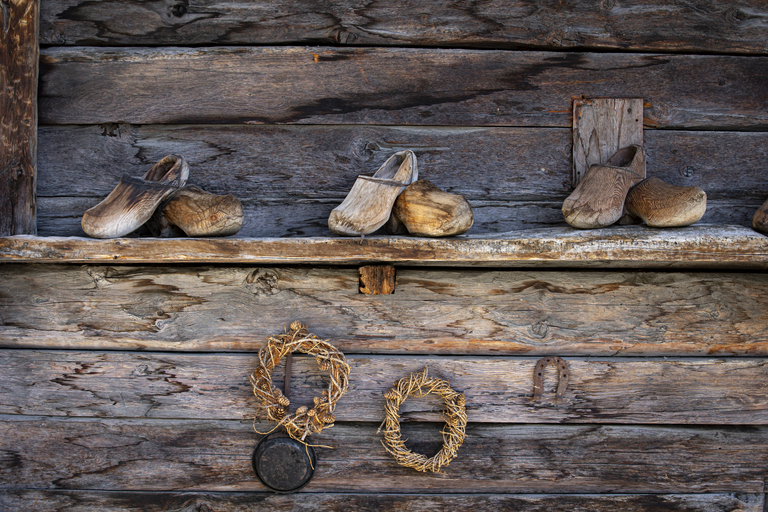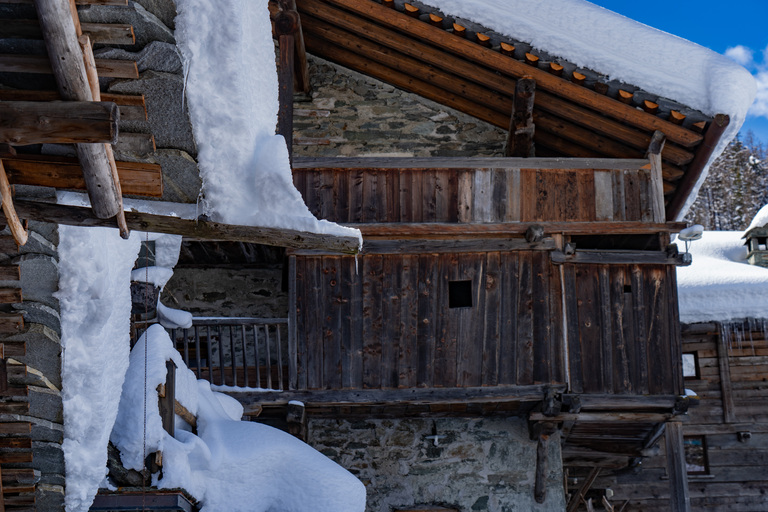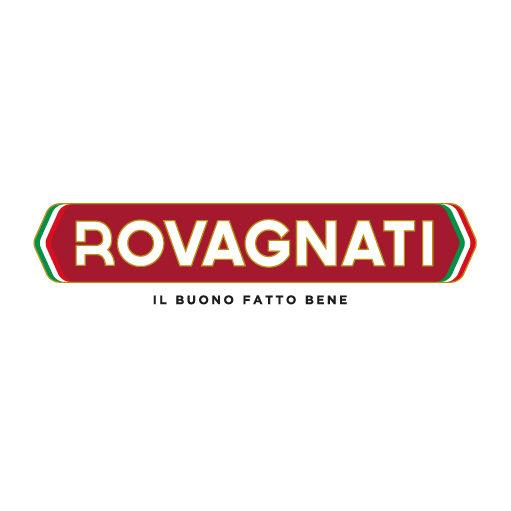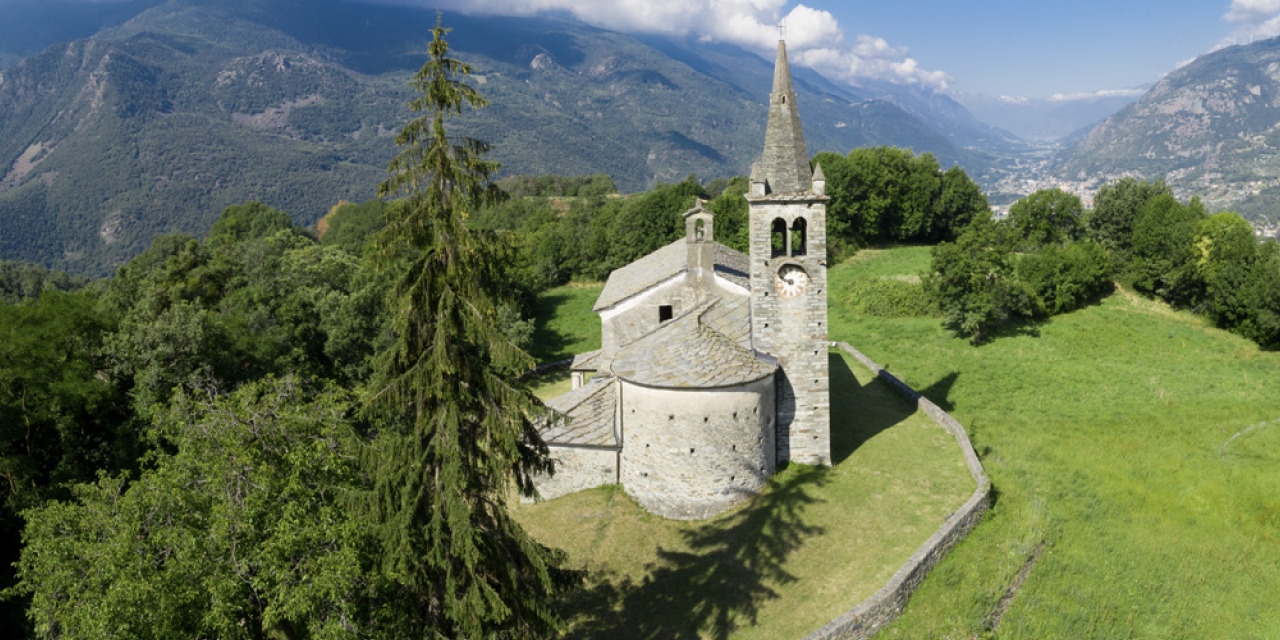
Tappa
16
Venerdì 30
Maggio 2025
46,8 km
Dislivello 1850 mt
Livello Tecnico: Avanzato
Impegno Fisico: Elevato

Saint Vincent -
Champoluc
Saint Vincent - Champoluc
info turistiche
Città di:
Saint Vincent
Overview
Saint-Vincent, the “Riviera delle Alpi”, presents itself as a true mountain jewel, capable of enchanting visitors with its magical and relaxing atmosphere. On a warm summer evening, the town’s main street comes alive with a special light, where the dusky sky is tinged with gold and scarlet, creating a picture that looks like something out of a painting.
Saint-Vincent’s evening life is an explosion of vitality and joy. The stone-paved streets resound with festive shouts, cheerful music, and the sound of glasses touching in toasts. Children run and laugh, while adults engage in animated conversations. In the square, performances capture the attention and applause of the audience. Some visitors, dressed in fancy clothes, head to the famous Casino, while others prefer to relax and enjoy the benefits of the local spa, renowned for its rejuvenating properties.
Gastronomy
The typical products of Valle d’Aosta tell, through taste, the story of an Alpine territory and its identity. The gastronomic tradition of Valle d’Aosta is a tale of unique flavours, the unrepeatable result of a particular geographical location, the quality of raw materials and ancient production techniques. Among the many specialties of Valle d’Aosta, those that have obtained “Protected Designation of Origin” (PDO) recognition stand out: Fontina, Valle d’Aosta Fromadzo, Jambon de Bosses and Vallée d’Aoste Lard d’Arnad. These products represent the excellence of the region’s cheese and charcuterie tradition, thanks to the use of high-quality milk and meat and processing methods handed down from generation to generation.
In addition to PDO cheeses and cured meats, Valle d’Aosta offers a rich variety of other gastronomic products. Among cured meats, Boudin, Saouseusse, Motzetta, Teuteun, and Saint-Oyen barbecued jambon are highly prized. Among the cheeses, brossa, Toma di Gressoney, salignön, reblec and seras deserve a mention. Each product has its own history and distinctive flavour, reflecting the local territory and traditions. These cheeses and cured meats are often accompanied by local fruits and nuts, which add further richness and variety to Valle d’Aosta dishes.
Fruit grown in Valle d’Aosta is another excellence of the area. The Renetta apple, a symbol of Valle d’Aosta fruit-growing tradition or the “Golden Delicious,” prized for its juicy, sugary flesh. Valle d’Aosta chestnut is a small but high-quality product. Valle d’Aosta honey, processed in the old-fashioned way without heat treatment, retains its organoleptic properties. Finally, the sweets and cookies typical of Valle d’Aosta valleys, such as the tegole and torcetti of Saint-Vincent, complete this rich gastronomic panorama, offering an irresistible touch of sweetness.
Wine and beverage
Nothing is lacking in Valle d’Aosta, especially when it comes to wine. This region offers a wide range of wines ranging from whites to rosés, reds to late harvests, and bubbles. Vines are grown on terraces supported by dry stone walls, an unmistakable feature of the landscape. Observing the vineyards that seem to climb steep mountain slopes, one immediately understands why the attribute “heroic viticulture” is used. Several farms offer wine-related experiences, including wine tastings, winery tours and trekking among the vineyards, allowing visitors to immerse themselves in the wine world of Valle d’Aosta.
In addition to wine, Valle d’Aosta is renowned for its grappas distilled from the precious pomace, distillates and bitters made from the alpine herbs that flourish at high altitudes. Known for their therapeutic properties, they include distinctive essences like artemisia glacialis and artemisia weber, the basic components of Genepi (once known as “génépy”), the famous Valle d’Aosta liqueur. Its chromatic-greenish-yellow appearance, balsamic fragrance and full, bitter taste derive precisely from the characteristics of those seedlings, sparingly harvested in glacier moraines, then selected and dried with painstaking meticulousness. Water is another essential element of mountain life, and Valle d’Aosta is famous for its pure, uncontaminated waters. The history of the Mont Blanc Company began in 1967, and it has been producing and marketing water from the sources of Mont Blanc ever since. These controlled, wellness-rich waters are a symbol of the region’s pristine environment. The motto “Drink healthy, drink Valle d’Aosta” reflects the strong link between the company and its territory, emphasizing the importance of environmentally conscious and respectful consumption.
Points of interest
Saint-Vincent is the ideal starting point for exploring the Media Valle, a land of rare beauty in which the gaze wanders between bold manors and fascinating strongholds, dotted as much with towers as with legends.
Saint-Vincent Casino – Roulette, blackjack, poker: these are just some of the games you’ll find in the glittering and refined halls of the Saint-Vincent Casino, the flagship of Europe’s gambling houses.
Saint-Vincent Thermal Baths – Immerse yourself in the waters of the Saint-Vincent thermal baths, a tepid caress with relaxing properties that winds its way through sparkling whirlpools, regenerating water jets and scenic relaxation terraces.
Col de Joux – A scenic boundary separating Val d’Ayas from Saint-Vincent, it is a triumph of lovely forests and evocative grasslands, from which the gaze reaches out to embrace the turquoise waters of the Dora Baltea and the jagged heights of Mont Blanc. Among immortal firs and tapering larches unravel adventurous hikes leading to the surrounding heights and pleasant walks that lose themselves among picturesque hamlets and periwinkle-colored lakes. In fine weather, this hill is a blossoming of trails for biking, while in winter it transforms into a snow paradise.
Mount Zerbion – You’ll feel like you’re on top of the world when your astonished eyes caress the snow-capped peaks of Cervino, Monte Rosa, Mont Blanc and Gran Paradiso. And a thrill of adrenaline will run through you the instant your gaze rests on the endless expanses of the Val d’Ayas and the distant profile of the central valley, losing itself among villages, narrow streets and shining lakes. There is no more scenic spot in this area than Mount Zerbion: so many ways to get to its summit, populated by solemn ibexes and protected by a silent, sacred guardian.
Castle Of Ussel – It looks like a red kite, perched on a wooded nest of rocks and bushes. Within its walls still echo the footsteps of guards, the cries of lookouts and the clangour of prisoners’ chains…
Fénis Castle – This is the most visited castle in Valle d’Aosta, with its crenellated walls, guard walkways, soaring towers and frescoes that tell of dragons and princesses. If you’re looking for a fairy tale place, you’ve just found it.
Saint-Barthélemy Astronomical Observatory- Join the compelling quest to unravel the mysteries of the universe: let yourself be guided on an evocative tour that iron, agricultural implements of yesteryear. A story, beautiful and overwhelming, told by one of the most extraordinary museums ever. It will bring you into the presence of elusive constellations, giant planets and fiery stars.
The village of Chamois: A Village On The Clouds – The highest municipality in Valle d’Aosta: an enchanting place totally surrounded by nature, an example of environmental sustainability and gentle mobility, reachable only on foot or by cable car.
Champoluc
Overview
Located in the Aosta Valley, Champoluc is a top ski resort in the Monte Rosa region. It offers stunning alpine scenery, excellent winter sports facilities, and scenic hiking trails, making it a year-round outdoor paradise.
Gastronomy
Champoluc, in the heart of the Ayas Valley, offers a typical cuisine that reflects the mountain traditions of Valle d’Aosta. Among the most representative dishes is the Valle d’Aosta fondue, a rich and creamy dish made with local cheeses such as Fontina, melted with milk, butter, and eggs, accompanied by toasted bread. Polenta concia, another traditional dish, is made with polenta served with melted butter and abundant cheese, perfect for warming up during cold winter days.
Meat-based dishes are a staple of Champoluc’s cuisine: among the most renowned are venison and chamois, often braised or served with herb-based sauces. Risotto alla valdostana, prepared with cheese and mushrooms, is another dish that encapsulates the flavors of the mountains.
Desserts include typical cakes such as the Valle d’Aosta apple cake or hazelnut cake, offering an authentic taste, perfect for ending a mountain meal. Honey and artisanal jam, both typical of the region, are often paired with cheese or simply enjoyed on their own. The cuisine of Champoluc is a true journey into traditional flavors, ideal for those wanting to immerse themselves in the authentic tastes of the Alps.
Wine and beverage
The typical drinks reflect the Valle d’Aosta tradition, offering a mix of aromas and flavors that perfectly complement the Alpine climate and mountain culture. One of the most representative beverages is Genepy, an aromatic and digestive liqueur made from Alpine herbs that grow at high altitudes. Its unique, slightly bitter taste makes it perfect after a hearty meal.
Another traditional beverage is Valle d’Aosta grappa, produced from local grapes or pomace, known for its strong flavor and ability to warm up cold winter evenings. Grappa is often served as a digestif, paired with cheeses or traditional desserts.
For those who prefer a sweeter drink, there is Valle d’Aosta honey, frequently used as a natural sweetener or mixed with hot water to create a warm, soothing drink, ideal for facing the harsh mountain temperatures.
Finally, Valle d’Aosta craft beer is gaining increasing popularity, thanks to local breweries that use regional ingredients such as hops and Alpine herbs. These fresh and flavorful beers are perfect to accompany a meal or simply for a moment of relaxation after a day of hiking.
Points of interest
The village is an ideal departure point for exploring the numerous attractions that enrich the area, offering unforgettable experiences for those passionate about history, nature, and mountain traditions.
One of the most historically significant sites is the Church of San Martino in Antagnod, a 15th-century church located in the homonymous hamlet. The church is a fine example of Alpine architecture, with a simple yet charming structure that harmonizes perfectly with the surrounding landscape. Inside, visitors can admire beautiful frescoes that narrate religious life and local traditions. The church is also an important reference point for the Champoluc community and a place of worship where religious devotion is celebrated.
The Ru Cortot da Barmasc is a historic trail that winds through the mountain landscape, following an ancient mule track that once connected the hamlets of Champoluc to the valley below. The route is particularly scenic, offering a breathtaking view of the village and the surrounding valley. Along the way, hikers can discover hidden corners and picturesque views that make the Ru Cortot an ideal destination for trekking and learning about local history.
The Monte Rosa Massif, one of the highest peaks in the Alps, is undoubtedly the highlight of Champoluc. The mountain is an unmissable destination for mountaineers and skiers, as well as for those who simply love to admire the breathtaking panorama it offers. Monte Rosa is a symbol of the majesty of the Alpine landscape, and its imposing presence dominates the Champoluc scenery, providing incredible opportunities for hiking, climbing, and ski touring.
Another enchanting destination is Lago Blu, located at 2,000 meters above sea level, accessible via an easy hike. This Alpine lake, surrounded by forests and snow-capped peaks, is a perfect spot for a peaceful walk, photography, or simply to enjoy the serenity of the landscape.
The Village of Mascognaz, one of the most charming corners of Champoluc, is an ancient hamlet that has preserved its traditional appearance. This picturesque mountain village, characterized by stone and wooden buildings, is perfect for those wanting to immerse themselves in history and local traditions. Mascognaz is also renowned for its panoramic location, offering an unparalleled view of the surrounding mountains. The village is the ideal place for a stroll to discover the ancient Walser houses and the traditions of the past.
Finally, Sabots are the traditional wooden clogs that have been used for centuries by the inhabitants of the Valle d’Aosta. A symbol of mountain traditions, sabots were once essential for working in the fields and facing harsh winter conditions. Today, these clogs have become a cultural heritage symbol and are often purchased as souvenirs, allowing visitors to take home a piece of Valle d’Aosta tradition.


